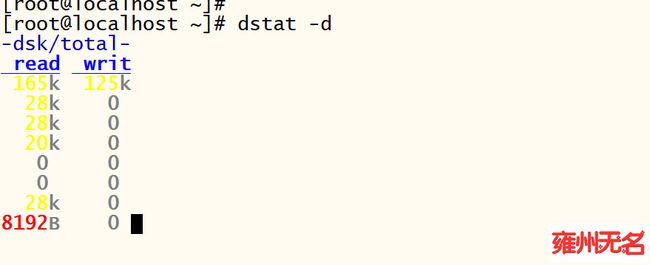使用Linux的dstat命令监控系统性能和资源
使用Linux的dstat命令监控系统性能和资源
在Linux系统中,了解系统的性能和资源使用情况对于有效管理和故障排除至关重要。dstat是一个功能丰富的命令行工具,它提供了实时监控和统计系统性能和资源的能力。本文将介绍如何使用dstat命令来监控关键指标并显示实时统计信息和图表。
1.安装dstat
在大多数Linux发行版中,dstat已经包含在软件仓库中,可以使用包管理器进行安装。例如,在CentOS系统中,可以使用以下命令安装dstat:
yum install dstat- 1.
安装完成后,您就可以开始使用dstat命令了。
2.基本用法
dstat命令非常灵活,可以监控各种系统指标,包括CPU使用率、内存使用、磁盘I/O、网络流量等。以下是dstat命令的基本用法:
dstat [options] [interval] [count]- 1.
options:用于指定要监控的指标,可以同时指定多个选项。
interval:指定采样数据的时间间隔(以秒为单位)。默认值为1秒。
count:指定采样数据的次数。如果未指定,则dstat将持续监控直到手动中断。
下面是一些常用的dstat选项:
-c:监控CPU使用率。
-m:监控内存使用情况。
-d:监控磁盘I/O。
-n:监控网络流量。
-p:监控进程和系统调用统计。
-s:监控系统运行状态。3.示例用法
(1).监控CPU使用率和系统负载
要监控CPU使用率和系统负载,可以运行以下命令:
dstat -c -l- 1.
这将显示实时的CPU使用率和系统负载情况。
(2).监控内存使用情况
要监控内存使用情况,可以运行以下命令:
dstat -m- 1.
Usage: dstat [-afv] [options..] [delay [count]]
Versatile tool for generating system resource statisticsDstat options:
-c, --cpu enable cpu stats
-C 0,3,total include cpu0, cpu3 and total
-d, --disk enable disk stats
-D total,hda include hda and total
-g, --page enable page stats
-i, --int enable interrupt stats
-I 5,eth2 include int5 and interrupt used by eth2
-l, --load enable load stats
-m, --mem enable memory stats
-n, --net enable network stats
-N eth1,total include eth1 and total
-p, --proc enable process stats
-r, --io enable io stats (I/O requests completed)
-s, --swap enable swap stats
-S swap1,total include swap1 and total
-t, --time enable time/date output
-T, --epoch enable time counter (seconds since epoch)
-y, --sys enable system stats--aio enable aio stats
--fs, --filesystem enable fs stats
--ipc enable ipc stats
--lock enable lock stats
--raw enable raw stats
--socket enable socket stats
--tcp enable tcp stats
--udp enable udp stats
--unix enable unix stats
--vm enable vm stats
--vm-adv enable advanced vm stats
--zones enable zoneinfo stats--list list all available plugins
--plugin enable external plugin by name (see --list)-a, --all equals -cdngy (default)
-f, --full automatically expand -C, -D, -I, -N and -S lists
-v, --vmstat equals -pmgdsc -D total--bits force bits for values expressed in bytes
--float force float values on screen
--integer force integer values on screen--bw, --black-on-white change colors for white background terminal
--color force colors
--nocolor disable colors
--noheaders disable repetitive headers
--noupdate disable intermediate updates
--output file write CSV output to file
--profile show profiling statistics when exiting dstatdelay is the delay in seconds between each update (default: 1)
count is the number of updates to display before exiting (default: unlimited)
这将显示实时的内存使用情况,包括已用内存、缓存、交换空间等。
(3).监控磁盘I/O
要监控磁盘I/O,可以运行以下命令:
dstat -d- 1.
这将显示实时的磁盘读写速率、IOPS等信息。
(4).监控网络流量
要监控网络流量,可以运行以下命令:
dstat -n- 1.
这将显示实时的网络流量情况,包括接收和发送的数据量。
(5).监控进程和系统调用统计
要监控进程和系统调用统计,可以运行以下命令:
dstat -p这将显示实时的进程和系统调用统计信息,包括进程的CPU使用率、内存使用、磁盘I/O等。
(6).监控系统swap
要监控系统swap,可以运行以下命令:
dstat -s这将显示实时的系统运行状态信息,包括上线时间、任务切换次数、中断次数等。
结论:
dstat是一个非常有用的Linux命令行工具,可以帮助您实时监控和统计系统性能和资源使用情况。通过使用dstat命令,您可以方便地监控CPU、内存、磁盘、网络等关键指标,并以实时统计信息和图表的形式进行展示。掌握dstat命令的使用方法,将为您管理和维护Linux系统提供有力的支持。




